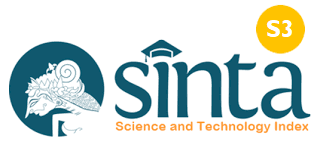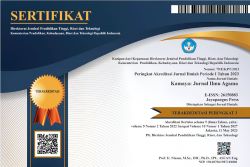Leksikal Tanaman Obat Tradisional Untuk Penyakit Anak Dalam Lontar Usadha Rare
DOI:
https://doi.org/10.1234/kamaya.v7i1.7Keywords:
Lexical, Medicinal Plants, Usada RareAbstract
The lack of attention to medicinal plants will cause the ecosystem and lexical medicinal plants to become more critical. Therefore, an in-depth study is needed to save biodiversity and lexical preservation of medicinal plants. The objectives of this study are (1) to describe the lexical medicinal plants in lontar Usada Rare; (2) to describe the clarification of usada figures related to traditional medicinal plants in lontar Usada Rare for childhood diseases. To achieve these objectives, the researcher used a qualitative descriptive design. Data collection in the first stage was carried out by content analysis on lontar Usada Rare. The second stage of the research design was an in-depth interview with usada figures about usada rare to clarify the content of the lontar.The researcher as a human instrument is equipped and supported by interview guidelines, recording devices, cameras, and notes. The data obtained through the Usada Rare manuscript, then carried out data review, data categorization, and extracting the value and concept of treatment. The analysis techniques in this research are 1) data reduction, 2) data presentation and 3) conclusion drawing. Based on the results of the research anddiscussion above, the conclusions in this study are as follows. There are 111 (One hundred and eleven) lexical medicinal plants in lontar usada rare; There are 4 balian/healer terms in usada bali namely balian ketakson, balian kepican, balian usada and balian campuhan. The sources of medicine in usada bali include: Taru Pramana (Trees with medicinal properties), Sato Pramana (Medicinal ingredients derived from animals), Toya Pramana (Medicinal ingredients derived from water), Bayu Pramana (Medicinal ingredients derived from strength).
References
Bagiastra, I. N., & Sudantra, I. K. (2019). Bali Dalam Pengembangan Pengobatan Tradisional Komplementer (Kajian Yuridis Peraturan Menteri Kesehatan Republik Indonesia Nomor 15 Tahun 2018 Tentang Penyelenggaraan Pelayanan Kesehatan Tradisional Komplementer). Jurnal Penelitian dan Pengembangan Sains dan Humaniora, 2(2), 88-97.
Kantor Dokumentasi Budaya Bali. (1997). Alih Aksara Lontar Tahun 1997 Usada Wwe. Pemerintah Propinsi Daerah Tingkat I Bali, Denpasar. 58 hal.
Pratika, N. (2017). Yoga Sastra Laku Mistik Balian Bali. Jurnal Dharmasmarti. 17(2)
Suardika, I. K. (2019). Pengobatan Tradisional Usada Dan Balian Budaya Bali (Kajian Ilmu Sosial Budaya). In Prosiding Seminar Nasional (p. 53)
Suardiana, I. W. (2018). Naskah pengobatan “Usada” di Bali dan Problematika Pemurnian Teks. Jurnal Kajian Bali, 8(2), 1-14.
Sutrisna, I. N. G. T., Widyastuti, N. L. G., & Cahyadi, K. D. (2019). Kajian Pengobatan Tradisional Cacar Menurut Terjemahan Lontar Usada Kacacar. Jurnal Riset Kefarmasian Indonesia, 1(1), 41-55.
Suatama, I. B. (2019). Masa Depan Usada Bali Dalam Wacana Modernitas. Widya Kesehatan, 1(2), 1-10.
Sanjaya, D. A., & Bhandesa, A. M. (2019). Studi Eksplorasi Pengobatan Pada Usada Pemunah Cetik Kerikan Gangsa. Jurnal Penelitian Agama Hindu, 3(2), 144-148.
Suatama, I. B. (2019). Multikulturalisme Usada Bali. Widya Kesehatan, 1(1), 11-17.
Yuliari, S. A. M. (2019). Panglukatan Sapta Gangga Perspektif Usada Bali. Vidya Wertta: Media Komunikasi Universitas Hindu Indonesia, 2(2), 178-191.
Triyono, S. D. K., & Herdiyanto, Y. K. (2017). Konsep Sehat Dan Sakit Pada Individu Dengan Urolithiasis (Kencing Batu) Di Kabupaten Klungkung, Bali. Jurnal Psikologi Udayana, 4(2), 263-276.
Downloads
Published
How to Cite
Issue
Section
License
An author who publishes in the Kamaya : Jurnal Ilmu Agama agrees to the following terms:
- Author retains the copyright and grants the journal the right of first publication of the work simultaneously licensed under the Creative Commons Attribution-ShareAlike 4.0 License that allows others to share the work with an acknowledgement of the work's authorship and initial publication in this journal
- Author is able to enter into separate, additional contractual arrangements for the non-exclusive distribution of the journal's published version of the work (e.g., post it to an institutional repository or publish it in a book) with the acknowledgement of its initial publication in this journal.
- Author is permitted and encouraged to post his/her work online (e.g., in institutional repositories or on their website) prior to and during the submission process, as it can lead to productive exchanges, as well as earlier and greater citation of the published work (See The Effect of Open Access).
Read more about the Creative Commons Attribution-ShareAlike 4.0 Licence here: https://creativecommons.org/licenses/by-sa/4.0/.





